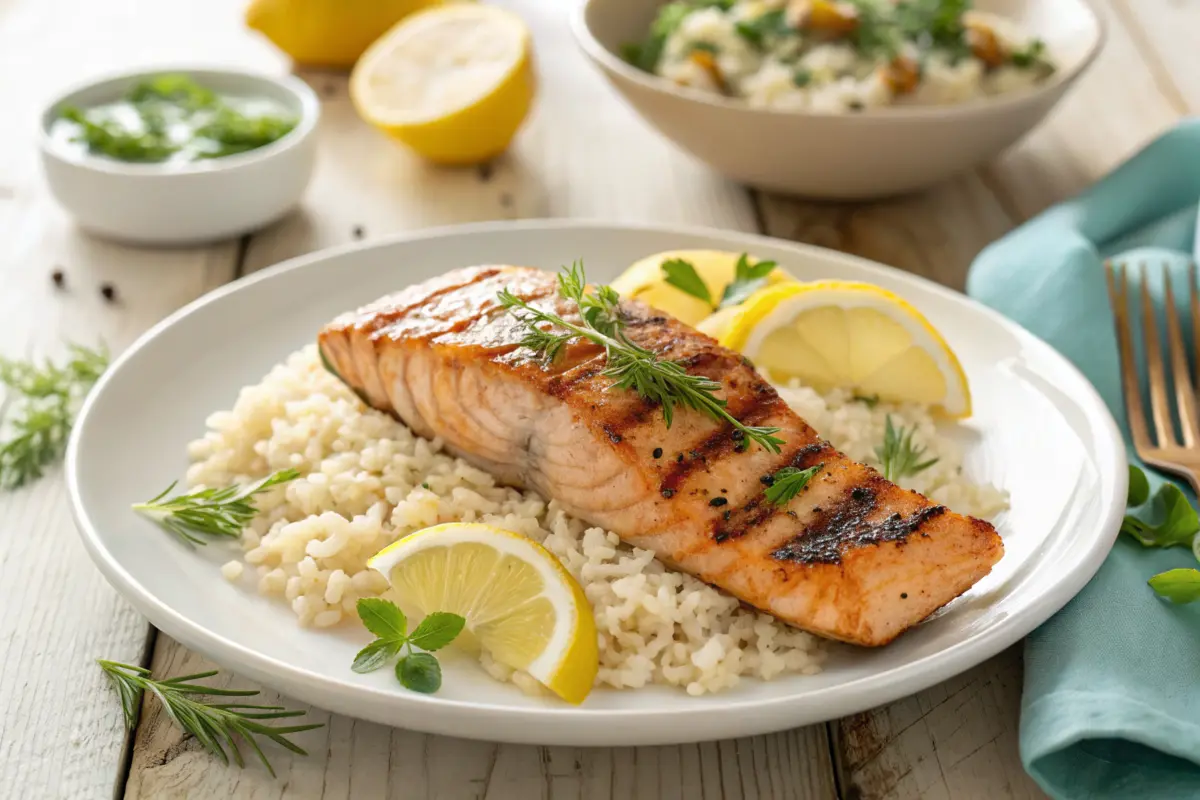Salmon and rice is a standout meal for its nutrition and versatility, making it a perfect choice for a healthy, balanced diet. Salmon is packed with protein and omega-3 fatty acids, while rice provides essential carbs and fiber. Together, they form a dish that supports heart health, boosts brain function, and provides lasting energy. This pairing also offers endless flavor options, from lemon-infused rice bowls to teriyaki-glazed fillets. In this guide, we’ll explore the health benefits of salmon and rice, the best types to use, cooking methods, and recipe ideas. Discover why salmon and rice is both delicious and nutritious.
Understanding the Healthiness of Salmon and Rice
Nutritional Breakdown of Salmon
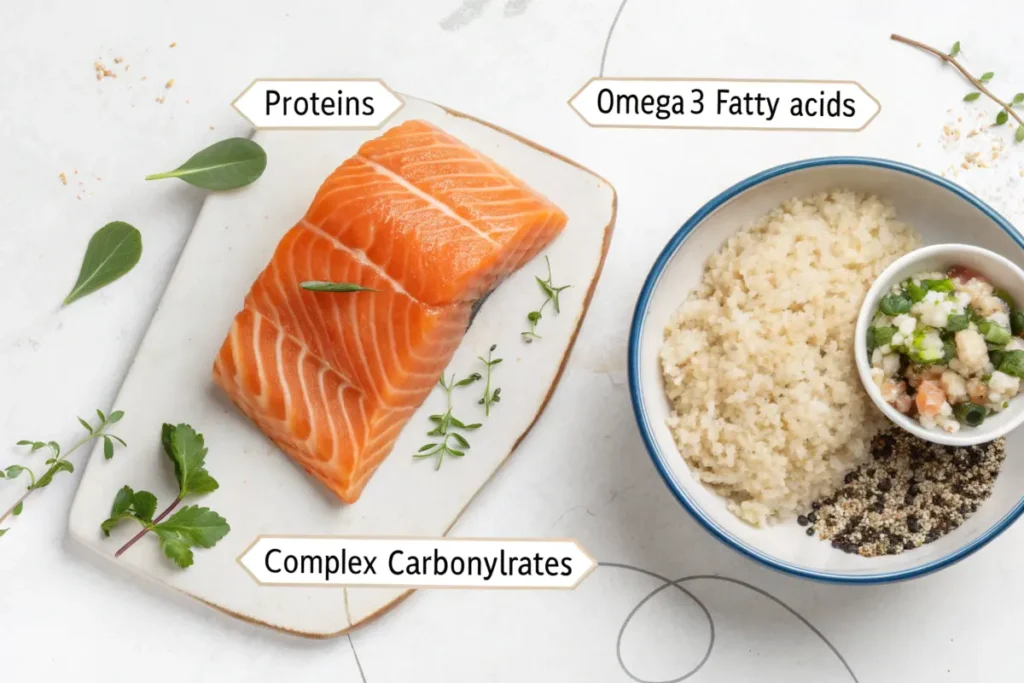
Salmon is a true superfood, offering high-quality protein essential for muscle repair and growth. Salmon is also rich in omega-3 fatty acids, especially EPA and DHA, which reduce inflammation, support heart health, and boost brain function. Packed with key nutrients, salmon provides Vitamin D for bone health, Vitamin B12 for nerve function, and selenium, an antioxidant that protects cells. Including salmon in your diet helps meet daily nutritional needs. When paired with rice, salmon becomes a cornerstone of healthy eating, creating a balanced and nutritious meal. Salmon and rice together make an excellent choice for both health and flavor.
Nutritional Breakdown of Rice
Rice is a staple food worldwide, offering complex carbohydrates that provide sustained energy. Brown rice, with its bran and germ intact, is a healthier option than polished white rice, as it is richer in fiber, vitamins, and minerals. Fiber in rice supports digestion, promotes regularity, and prevents constipation. Additionally, rice is naturally gluten-free, making it a great choice for those with gluten sensitivities or celiac disease. The glycemic index of rice varies, with brown rice and basmati rice having lower indexes than white rice, making them beneficial for blood sugar control. When paired with salmon, rice becomes part of a balanced, nutrient-rich meal. Choosing the right type of rice enhances the overall nutritional value of your salmon and rice dish, aligning with your dietary preferences.
Combining Salmon and Rice for a Balanced Meal
When paired together, salmon and rice create a balanced meal that combines lean protein, healthy fats, and complex carbohydrates. This synergy ensures a well-rounded intake of essential nutrients, supporting overall health and providing sustained energy. Additionally, the versatility of both ingredients allows for endless culinary creativity.
Selecting Quality Ingredients for a Healthy Meal
Choosing the Best Salmon
Choosing high-quality salmon is essential for a delicious and nutritious salmon and rice meal. Fresh salmon offers a richer flavor and firmer texture, making it ideal for creating the best salmon and rice dishes. Look for vibrant, shiny flesh and a mild, ocean-like scent, avoiding strong or fishy odors. If fresh salmon isn’t available, frozen salmon is a reliable alternative, as long as it’s stored properly and thawed in the fridge. Decide between wild-caught and farmed salmon: wild-caught salmon is higher in omega-3s and boasts a robust flavor, while farmed salmon is more affordable and widely accessible. Whichever option you choose, high-quality salmon ensures your salmon and rice dish is both healthy and flavorful.
Selecting the Right Rice Type
The type of rice you choose greatly affects the healthiness and texture of your salmon and rice meal. Brown rice, with its bran and germ layers intact, provides more fiber, vitamins, and minerals than white rice, supporting digestion and sustained energy. For a slightly sticky and fragrant option, jasmine rice complements Asian-inspired salmon and rice dishes. Basmati rice, with its long, fluffy grains, pairs beautifully with Mediterranean or Middle Eastern flavors, enhancing your salmon and rice meal. Wild rice is another excellent choice, offering a lower glycemic index, protein, and antioxidants for stable blood sugar levels. Each type of rice brings unique benefits, allowing you to customize your salmon and rice meal to suit your dietary preferences and taste.
Incorporating Fresh Vegetables and Herbs
Enhance your salmon and rice meal with fresh vegetables and herbs to elevate both nutrition and flavor. Leafy greens like spinach or kale add fiber and vitamins, making your salmon and rice dish even healthier. Crunchy vegetables like bell peppers, carrots, and cucumbers contribute texture and vibrant colors to your plate. Fresh herbs such as dill, parsley, and cilantro provide aromatic qualities that pair perfectly with salmon and rice, without adding extra calories. Aromatics like garlic, ginger, and scallions deepen the flavor profile of your salmon and rice meal. Balancing these ingredients creates a nutrient-packed dish that supports your health while satisfying your taste buds.
Essential Tools and Kitchen Prep
Kitchen Equipment for Salmon and Rice Recipes
Creating a wholesome salmon and rice meal starts with the right kitchen tools. A nonstick or cast-iron skillet is essential for perfectly seared salmon—crispy on the outside and tender inside. A rice cooker simplifies cooking rice, delivering consistent results without guesswork. Alternatively, a sturdy saucepan with a tight lid works well for stovetop rice. Sharp knives are crucial for cleanly filleting salmon, improving both presentation and cooking consistency. Other helpful tools include measuring cups for accurate portions and cutting boards to keep your workspace clean. These essentials ensure delicious and visually appealing salmon and rice dishes every time.
Preparing Salmon for Cooking
Proper salmon preparation is key to maximizing flavor and texture in your salmon and rice meal. Start by patting the salmon dry with paper towels to achieve a crispy skin when searing or grilling. Use tweezers to remove pin bones for a smooth dining experience. For frozen salmon, thaw it in the refrigerator overnight or use the cold-water method for a quicker thaw. Avoid microwaving, as it can partially cook the fish and ruin its texture. Marinating the salmon with citrus, herbs, and soy sauce adds extra flavor and enhances the dish. These steps ensure perfectly cooked, tender, and flavorful salmon every time.
Prepping Rice for Perfect Texture
Perfectly cooked rice is essential for a great salmon and rice meal. Start by rinsing the rice under cold water until it runs clear to remove excess starch and avoid gumminess. Use a 2:1 water-to-rice ratio for most long-grain varieties, like jasmine or basmati, or follow package instructions. After cooking, let the rice rest covered for 10 minutes to evenly distribute moisture and firm up the grains. Finally, fluff the rice with a fork to achieve a light, fluffy texture. These steps ensure a perfect base to complement the rich flavors of your salmon and seasonings.
Cooking Methods and Techniques
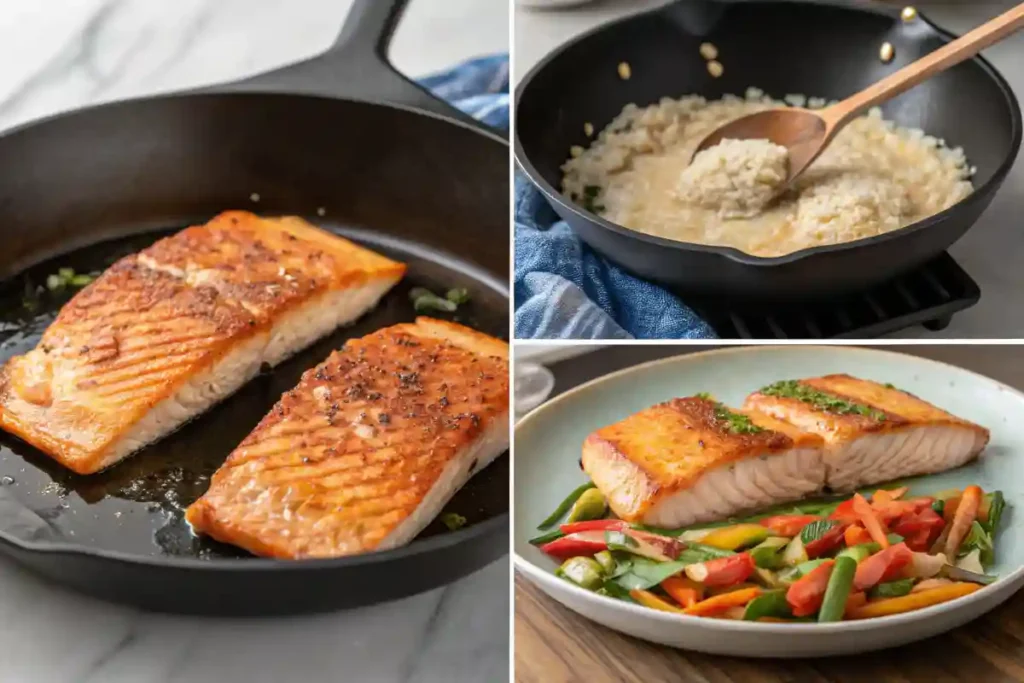
Pan-Searing and Grilling Salmon
Salmon and rice make a nutritious, balanced meal, combining lean protein, omega-3s, and complex carbs, especially with added vegetables. Pan-searing and grilling enhance flavor and texture while keeping the salmon moist. To pan-sear, heat olive oil in a skillet, cook the salmon skin-side down for 4-5 minutes until crispy, then flip and finish to your liking. For grilling, preheat to medium-high, oil the grates, and cook skin-side down for 6-8 minutes per side until the salmon flakes. Both methods bring out the salmon’s natural flavors, creating a healthy and delicious dish.
Roasting Salmon and Baking
Baking and roasting are gentle cooking methods that preserve the delicate texture and rich flavors of salmon, making them excellent choices for healthy salmon and rice meals. Baking ensures even cooking and allows you to infuse the fish with various flavors. Preheat your oven to 400°F (200°C) and place the salmon fillets on a parchment-lined baking sheet. Season with fresh herbs, lemon slices, and a drizzle of olive oil for added moisture. Bake for 12-15 minutes, or until the salmon is opaque and flakes easily with a fork. Roasting uses higher heat for a shorter time to achieve a caramelized exterior. Use a roasting pan and elevate the salmon on a rack for even heat circulation. Roast at 425°F (220°C) for about 10-12 minutes, resulting in a succulent, flavorful dish with a hint of crispiness. Both methods allow creative seasoning combinations, keeping your nutritious salmon rice dishes exciting and delicious
Poaching and Steaming Salmon
Poaching and steaming are excellent methods to prepare salmon and answer the question, Is salmon and rice a healthy meal? These techniques enhance the salmon’s natural flavors without adding fat, making them perfect for health-conscious meals. To poach, simmer a flavorful liquid like broth or wine with herbs, add the salmon, cover, and cook for 10-12 minutes, ensuring it stays tender and moist. For steaming, place the salmon in a steamer basket over boiling water and cook for 8-10 minutes. Both methods preserve the salmon’s texture and gently infuse flavors, demonstrating why salmon and rice is a healthy meal choice with clean, pure tastes..
Flavor Profiles and Seasonings
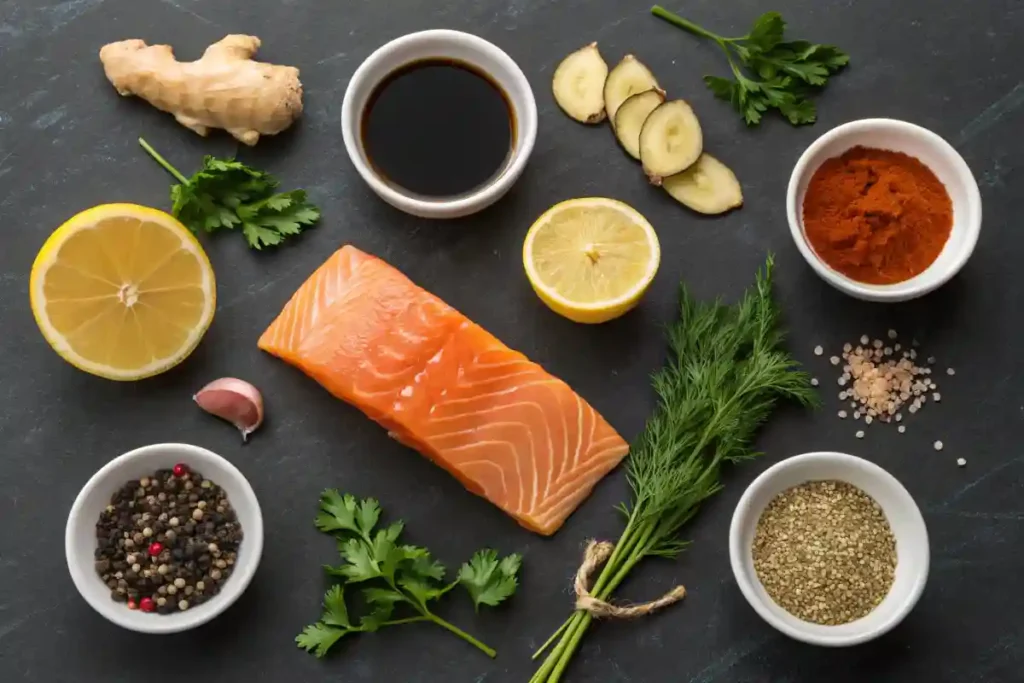
Marinades, Rubs, and Glazes
Enhance your salmon and rice meal with flavorful marinades, rubs, and glazes. Citrus-soy marinades provide a tangy, umami-rich profile, perfect for quick meals. Combine soy sauce, lemon juice, garlic, and honey for a balanced glaze that caramelizes beautifully when grilled or baked. For a sweet and spicy kick, try a honey-ginger glaze made with honey, grated ginger, and rice vinegar, brushing it on during the final minutes of cooking. Bold options like miso or teriyaki infusions add a savory-sweet depth that pairs well with brown or jasmine rice. These simple enhancements elevate your dish with gourmet flavor and style.
Herbs, Spices, and Aromatics
The right combination of herbs, spices, and aromatics can elevate your salmon and rice meal from ordinary to extraordinary. Dill adds a fresh, tangy flavor that brightens the salmon without overpowering it. Parsley and chives offer mild, herbal notes that complement various seasoning blends. Garlic and ginger introduce robust, aromatic qualities, deepening the overall flavor profile and making your dishes more enticing. Scallions add a subtle, onion-like sharpness, perfect for garnishing and adding crunch. Balancing these herbs and spices is key—too much of one can overshadow the others, while the right mix enhances the salmon’s natural taste. Incorporating savory and sweet elements, such as a hint of brown sugar or a squeeze of lemon, creates a harmonious flavor experience. These aromatics not only boost taste but also add visual appeal, making your meals as beautiful as they are delicious.
Incorporating Vegetables and Sauces
Adding vegetables and sauces to your salmon and rice meal enhances both nutrition and flavor. Roasted broccoli, stir-fried bok choy, or grilled asparagus provide texture, color, and balance. A creamy avocado sauce or tangy citrus vinaigrette complements the salmon’s richness, while crunchy radish slices or pickled vegetables add refreshing contrast. These additions elevate the dish, creating a visually appealing, flavorful, and satisfying meal that delights both the eyes and the palate.
Building a Salmon Rice Bowl
Creating a salmon rice bowl is all about layering flavors and textures for a harmonious and satisfying meal. Start with a base of your chosen rice—brown, jasmine, or basmati—to provide a hearty foundation. Add your cooked salmon, whether it’s pan-seared, grilled, or baked, ensuring it’s tender and flavorful. Layer in pickled veggies, such as carrots or cucumbers, for a tangy bite, and sprinkle with sesame seeds for a nutty crunch. Fresh citrus squeezes like lemon or lime can brighten the dish, while herb garnishes like cilantro or parsley add a burst of color and freshness. By thoughtfully combining these elements, your salmon rice bowl becomes a balanced, nutritious, and delicious meal that’s both easy to prepare and delightful to eat.
Recipe Ideas and Inspirations
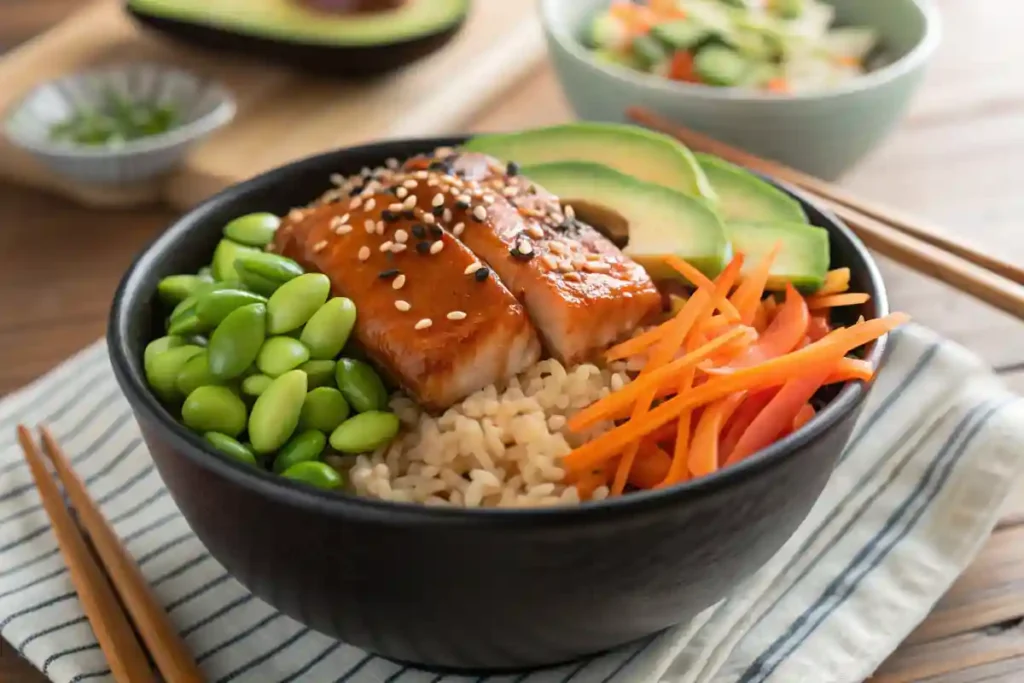
Classic Grilled Salmon with Lemon Rice
For a classic favorite that answers the question, Is salmon and rice a healthy meal?, try Grilled Salmon with Lemon Rice. Marinate salmon fillets in olive oil, lemon juice, garlic, and fresh herbs like dill or parsley for a flavorful, nutrient-packed dish. Preheat the grill to medium-high and cook the salmon for 4-5 minutes per side, achieving a perfect char while keeping it moist and flaky. Pair with fluffy lemon-infused rice by mixing cooked jasmine or basmati rice with lemon zest and a splash of lemon juice. This bright, zesty combination highlights why salmon and rice is a healthy meal that’s both elegant and easy to prepare.
Teriyaki Salmon Bowl with Brown Rice
Elevate your meal with a Teriyaki Salmon Bowl with Brown Rice. Begin by glazing your salmon with a homemade or store-bought teriyaki sauce, allowing it to soak up the sweet and savory flavors for at least 30 minutes. Cook nutty brown rice as your base, providing a hearty and fiber-rich foundation. Pan-sear or bake the teriyaki-glazed salmon until it’s tender and caramelized. Assemble your bowl by layering the brown rice, adding the succulent salmon on top, and garnishing with steamed vegetables like broccoli and snap peas. Sprinkle with sesame seeds and sliced green onions for an extra layer of flavor and crunch. This dish not only tastes amazing but also packs a nutritional punch, making it perfect for a wholesome lunch or dinner.
Miso-Glazed Salmon with Basmati Rice
Discover the umami-rich delight of Miso-Glazed Salmon with Basmati Rice. Create a luscious miso glaze by combining white miso paste, mirin, soy sauce, and a touch of honey or maple syrup. Brush this mixture generously over your salmon fillets and let them marinate for at least an hour to absorb the deep flavors. Bake the salmon in a preheated oven at 400°F (200°C) for about 12-15 minutes until it’s beautifully glazed and flaky. Pair it with fragrant basmati rice, cooked to perfection, which complements the savory miso glaze. Add a side of sautéed bok choy or steamed green beans to round out the meal. This recipe offers a sophisticated twist on traditional salmon dishes, perfect for impressing guests or enjoying a gourmet meal at home.
Sushi-Inspired Salmon and Rice Rolls
Bring the art of sushi into your kitchen with Sushi-Inspired Salmon and Rice Rolls. Use nori sheets to wrap seasoned sushi rice and slices of fresh salmon, along with avocado and cucumber for added crunch. Slice into bite-sized rolls and serve with soy sauce, pickled ginger, and wasabi for an authentic and delightful appetizer or light meal.
Nutrition, Sustainability, and Tips
Health Benefits of Salmon and Rice Meals
Combining salmon and rice offers numerous health benefits. Salmon provides high-quality protein for muscle repair and omega-3 fatty acids (EPA and DHA) that support heart health, reduce inflammation, and boost brain function. Whole-grain rice varieties, like brown or basmati, add complex carbohydrates for sustained energy and fiber for digestive health. Together, they create a balanced meal that promotes overall well-being, aids in weight management by increasing satiety, and delivers essential nutrients such as Vitamin D, B12, and selenium.
Sustainable Seafood Choices
Choosing sustainable seafood is essential for protecting marine ecosystems and ensuring future fish populations. When buying salmon, prioritize wild-caught varieties or those certified by organizations like Seafood Watch by the Monterey Bay Aquarium. These certifications indicate responsible sourcing that minimizes environmental impact and supports healthy fish stocks. Farmed salmon can also be sustainable when sourced from eco-friendly farms with reduced antibiotic use and low habitat disruption. Look for labels like MSC (Marine Stewardship Council) or ASC (Aquaculture Stewardship Council) to ensure your choice supports ethical fishing practices and marine conservation.
Meal Prep and Leftover Suggestions
Maximize the convenience and nutritional value of your salmon and rice meals through effective meal prep and creative use of leftovers. Bulk cooking salmon fillets and rice at the beginning of the week can save time and streamline your meal planning. Store cooked salmon and rice separately in airtight containers in the refrigerator for up to three days. Use leftovers in various dishes such as salmon salads, fried rice, or wraps to keep meals interesting and prevent food waste. Incorporating fresh vegetables and different sauces can transform leftovers into new, delicious meals. Additionally, consider freezing individual portions for longer storage, allowing you to enjoy nutritious, homemade meals even on your busiest days. These strategies not only enhance meal variety but also support a balanced and sustainable eating habit.
FAQs (People Also Ask)
Is salmon and rice a balanced meal?
Yes, combining salmon and rice creates a balanced meal by pairing high-quality protein and healthy fats from salmon with complex carbohydrates and fiber from rice. This combination provides essential nutrients that support overall health and sustained energy throughout the day.
What are the health benefits of eating salmon and rice?
Eating salmon and rice offers numerous health benefits, including high levels of omega-3 fatty acids for heart and brain health, lean protein for muscle maintenance, and complex carbohydrates for sustained energy. Additionally, this combination provides essential vitamins and minerals like Vitamin D, B12, and selenium.
Can salmon and rice help with weight loss?
Yes, salmon and rice can be part of a weight loss diet when portion-controlled. Salmon provides satiating protein and healthy fats that keep you full, while rice offers energy through complex carbohydrates. Pairing them with plenty of vegetables can create a nutritious, low-calorie meal that supports weight management.
How often should I eat salmon and rice for a healthy diet?
Incorporating salmon and rice into your diet 2-3 times a week can contribute to a healthy eating plan. This frequency ensures you receive the beneficial omega-3 fatty acids and protein from salmon while enjoying the energy and nutrients from rice. Variety in preparation keeps meals enjoyable and balanced.
Are there any drawbacks to eating salmon and rice regularly?
While salmon and rice are nutritious, consuming them excessively may lead to an imbalanced diet. It’s important to vary your protein sources and include a wide range of vegetables and whole grains. Additionally, be mindful of the type of rice you consume and portion sizes to maintain overall health.
Conclusion
Recapping the versatility and nutritional value of salmon and rice meals shows why they are a global favorite. Choose fresh salmon and the right rice type for every palate. Master cooking techniques and explore diverse flavors to enhance your meals. Opt for responsibly sourced seafood to support sustainability and enjoy health benefits. Prep ahead for busy weeks or create gourmet dinners with ease. Dive into the world of salmon and rice, experiment with flavors, and savor these delicious, balanced meals.

